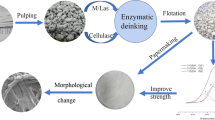Abstract
The benefits of bio-deinking of waste paper are investigated in this study. Enzymatic modification of mixed office waste paper and old magazine pulps was performed at two temperatures, 20 and 50 °C. Nonionic surfactant with different hydrophile–lipophile balance values and sodium tripolyphosphate was used as the deinking agent. The deinking process was conducted for pulps with and without enzymatic treatment. The results show that, for mixed office waste paper and old magazine pulps, the highest strength properties are achieved using lower hydrophile–lipophile balance at 20 and 50 °C, respectively, while using higher hydrophile–lipophile balance has a significant influence on the optical properties at 50 °C. Further, the results show in the presence of sodium tripolyphosphate, the optical properties of treated pulps, especially old magazine pulp significantly improved at 20 °C (ESST system). For mixed office waste paper, the optimum values of burst, tear and tensile indices, folding endurance, E-MOD, tensile energy absorption and elongation are 2.97 (kPa m2/g), 7.68 (mN m2/g), 93.47 (N m/g), 13, 8024 (GPa), 100.16 (J/m2) and 2.53 (%), respectively. Moreover, the results from measuring optical properties of handsheets show that the optimum values of brightness, dirt count, dirt area and deinking efficiency are 44.72 (%), 11, 0.221 (mm2) and 78.07 (%) correspondingly, while for old magazine, the formers are 2.35 (kPa m2/g), 6.77 (mN m2/g), 77.77 (N m/g), 9, 6199 (GPa), 72.61 (J/m2) and 2.37 (%) and the latters are 60.93 (%), 1, 0.005 (mm2) and 99.52 (%), respectively.


Similar content being viewed by others
References
Bobu E, Ciolacu F, Cretu A (2008) Deinkability of mixed prints: alkaline vs. neutral deinking. Prog Pap Recycl 18(1):23–31
Elegir G, Panizza E, Canetti M (2000) Neutral enzyme deinking of office waste with amylase/cellulase xerographic assisted mixture. Tappi J 83(11):40–44
Fricker A, Thompson R, Manning A (2007) Novel solutions to new problems in paper deinking. Pigment Resin Tech 36(3):141–152
Gübitz GM, Mansfield SD, Böhm D, Saddler JN (1998) Effect of endoglucanases and hemicellulases in magnetic and flotation deinking of xerographic and laser-printed papers. J Biotechnol 65:209–215
Hannuksela T, Rosencrance S (2008) Deinking Chemistry. Published online as chapter six, deinking primer, pp 1–12
Heise OU, Unwin JP, Klungness JH, Fineran WG, Sykes MS, Abubakr S (1997) Industrial scaleup of enzyme-enhanced deinking of nonimpact printed toners. Tappi J 79(3):207–212
Ibara D, Monte MC, Blanco A, Martinez AT, Martinez MJ (2012) Enzymatic deinking of secondary fibers: cellulases/hemicellulases versus laccase-mediator system. J Ind Microbiol Biotechnol 39:1–9
Jeffries TW, Klungness JH, Sykes S, Rutledge-Cropsey K (1994) Comparison of enzyme-enhanced with conventional deinking of xerographic and laser-printed paper. Tappi J 77(4):173–179
Jeffries TW, Sykes MS, Rutledge-Cropsey K, Klungness JH, Abubakr S (1995) Enhanced removal of toners from office waste papers by microbial cellulases. In: Sixth international conference on biotech. Pulp and Paper Industry, pp 141–144
Kim TJ, Ow SK, Eom TJ (1991) Enzymatic deinking methods waste paper. In: Tappi pulping conference proceedings, pp 1023–1031
Knudsen O, Young JD, Yang JL (1998) Long-term use of enzymatic deinking at Stora Dalum plant. In: Seventh international conference biotech. Pulp Paper Industry, pp A17–A20
Marques S, Pala H, Alves L, Amaral-Collaço MT, Gama FM, Gίrio FM (2003) Characterisation and application of glycanases secreted by Aspergillus terreus CCMI 498 and Trichoderma viride CCMI 84 for enzymatic deinking of mixed office wastepaper. J Biotechnol 100(3):209–219
Mayeli N, Talaeipour M (2010) Effect of different HLB value and enzymatic treatment on the properties of old newspaper deinked pulp. Bioresour J 5(4):2520–2534
Misner M (1992) The emerging world of deinking. Waste Age, pp 86–94
Morrow H, Horacek B, Hale K, Rosencrance S (2005) True-neutral deinking. Paper Age 121:34–35
Nakano J (1993) Recent research trends of pulping chemistry. Appik J 25(1):85–91
Oh JT, Park KN, Park JW, Kim JH (1997) Effects of HLB value of surfactant on enzymatic deinking process. J Ind Eng Chem 3(1):7–12
Patrick K (2004) Enzyme technology improves efficiency, cost, safety of stickies removal program. Paper Age 120(6):22–25
Pèlach MA, Pastor FJ, Puig J, Vilaseca F, Mutjè P (2003) Enzymic deinking of old newspapers with cellulase. Process Biochem J 38(7):1063–1067
Rutledge-Cropsey K, Klungness JH, Abubakr S (1998) Performance of enzymatically deinked recovered paper on paper machine runnability. Tappi J 81(2):148–151
Senior DJ, Hamilton J (1992) Biobleaching with xylanses brings biotechnology to Reality. Pulp Paper 66(9):111–114
Shrinath A, Szewczak JT, Bowen IJ (1991) A review of ink removal techniques in current deinking technology. Tappi J 74:85–93
Sykes MS, Tan F (1997) Enzymatic removal of stickie contaminants. In: Tappi pulping conference proceedings, pp 687–691
Sykes MS, Klungness JH, Gleisner R, Abubakr S (1998) Stickie removal using neutral enzymatic repulping and pressure screening. In: Tappi recycling, symposium notes, pp 291–297
Vyas S, Lachke A (2003) Biodeinking of mixed office waste paper by alkaline active cellulases from alkalotolerant Fusarium sp. Enzyme Microb Technol 32(10):236–245
Xu QH, Fu Y, Gao Y, Qin M (2009) Performance and efficiency of old newspaper deinking by combining cellulase/hemicellulase with laccase-violuric acid system. Waste Manag J 29(5):1486–1490
Xu Q, Wang YP, Qin MH, Fu YJ, Li ZQ, Zhang FS, Li JH (2011) Fiber surface characterization of old newsprint pulp deinked by combining hemicellulase with laccase-mediator system. Bioresour J 102(11):6536–6540
Zeyer C, Joyce TW, Heitmann JA, Rucker JW (1994) Factors influencing enzyme deinking of recycled fiber. Tappi J 77(10):169–177
Zhang X, Renaud S, Paice M (2008) Cellulase deinking of fresh and aged recycled newsprint/magazines (ONP/OMG). Enzyme Microb Technol 43(2):103–108
Zöllner HK, Schroeder LR (1998) Enzymatic deinking of nonimpact printed white office paper with a-amylase. Tappi J 81(3):166–170
Acknowledgments
The authors would like to acknowledge support from the CHOUKA company of Gilan and Mahd-e-Tage company of Tehran, Iran, for the use of laboratory facilities.
Author information
Authors and Affiliations
Corresponding author
Rights and permissions
About this article
Cite this article
Mayeli, N., Talaeipour, M. Influence of hydrophile–lipophile balance and sodium tripolyphosphate on the properties of biological deinked pulps. Int. J. Environ. Sci. Technol. 12, 3587–3596 (2015). https://doi.org/10.1007/s13762-015-0794-1
Received:
Revised:
Accepted:
Published:
Issue Date:
DOI: https://doi.org/10.1007/s13762-015-0794-1




